Velo-City Global Cycling Summit Journal: Day 6 & 7
Max Hepp-Buchanan, Director of Bike Walk RVA for Sports Backers, is attending the annual Velo-City Global Cycling Summit, this year in Nijmegen, the Netherlands. While there, he is leading a session alongside Heather Barrar of Chesterfield County to bring a story of advocacy and community engagement in Chesterfield County to a global audience. He’ll be sharing his thoughts, photos, and videos during the 10-day trip. Check out Day 1-2 here, and Day 3-5 here.
Day 6 & 7: Lost in Amsterdam
On Wednesday (Day Six), Heather and I got off the train in Amsterdam Central and walked with a group of conference attendees to a fleet of bikes near the station. Our mission: “Be an Amsterdammer for a day.” We picked up a couple of bikes and were handed a large manila envelope with the word “student” written on it. Inside we received a bike map of Amsterdam and instructions for where to go and what to do. “Okay Heather, let’s go do some Amsterdamage,” I said before we rode off into the busy city center.
The last time I had been to Amsterdam Central was in 2010 while doing research in graduate school. My wife Anna and I made a five-week trip out of traveling around Europe studying bike-share programs, as they were still not prevalent in the United States. At the time, we were reluctant to cycle through the city center. The sheer number of people riding bikes was overwhelming and we found it hard to even walk without getting plowed into by a heavy Dutch bicycle. It was culture shock.
I’m glad to say that was not the case this time, maybe because Heather and I had eased into it on group cycling tours in Nijmegen and The Hague. We set off with gusto to tackle our first challenge: go to the urban planning school at the University of Amsterdam and meet with the school’s ‘Bicycle Professor,’ one of the leading researchers on bicycle transport here in Holland.
The cycle paths were congested and it was hard to follow the map and ride at the same time. We really wanted to get there without using technology, but we probably looked silly dealing with a large unwieldy traditional map and stopping every few blocks to make sure we didn’t miss a turn. While we were attempting to be Amsterdammers for a day, we looked more like lost tourists. But we were having fun.
We finally found the university and went inside where we had a quick lesson and took a short exam. We both passed. Our next task was to go to a popular bar along the river for a quick beer before attending the big reception for the day. We were all for that beer, as we had worked hard to make it this far. But as I buzzed through a busy intersection and made a quick turn, I looked behind me and Heather was not there. I stopped to wait for her, but she didn’t come. I got a little flustered and then took stock of the situation. I had the map, but Heather had the addresses and a working smartphone. I found a wifi connection and emailed her that I was going straight to the reception. She responded that she’d do her best to find it.
Long story short, one long, sweaty, and haphazard bike ride later, I found myself in the park where the reception was located, looking for a wifi connection so I could communicate with Heather. She rolled up shortly after and dinged her bell. She had a big smile on her face and we were both proud to have navigated through the hectic streets of Amsterdam on our own.
The next day (Day Seven), we finally did what we came here to do: we presented our story of working together to ensure the passage of the Chesterfield County Bikeways and Trails Plan. About 45 people from around the world attended our presentation – advocates, planners, academics, and elected officials from America, Brazil, Scotland, Australia, Germany, Holland, England, and many other countries. The discussion following our talk was expertly moderated by Reindert Augustijn, a transportation official from Nijmegen and one of the Velo-City conference organizers. It felt awkward showing images of dire biking and walking conditions from our home in the best cycling city in the world. The contrast was stark and clear. But the fact that we were even able to get a plan like that adopted in a rural/suburban and politically conservative area in the face of organized opposition was perceived as quite amazing to the audience, especially the Dutch. We also learned that we are not alone in our uphill battles. After the presentation, we stuck around to talk with people who wanted to know more about the relationship between advocates and professional planners and how advocacy influences the decision-making process in the Richmond region.
While 45 attendees at a conference of 1,500 people is not overly impressive, other summit participants heard about our story and in the days afterwards we were approached by people who wanted to continue the conversation. In some cases, the topic was exaggerated, like a game of telephone (no, we are not “saving the people of Appalachia,” whatever that means). But we were kind of okay with that. It means that our story was heard and resonated with people who probably don’t know Richmond, Virginia, USA like we do, but can appreciate the work we do for reasons relating to their own communities.
###

